Parsley pesto is a great and more affordable version of the traditional basil pesto. Parsley also has a great flavor and the same beautiful green color. It’s a great idea to use up lots of parsley! You can use it just like the basil pesto – as a condiment or pasta sauce.
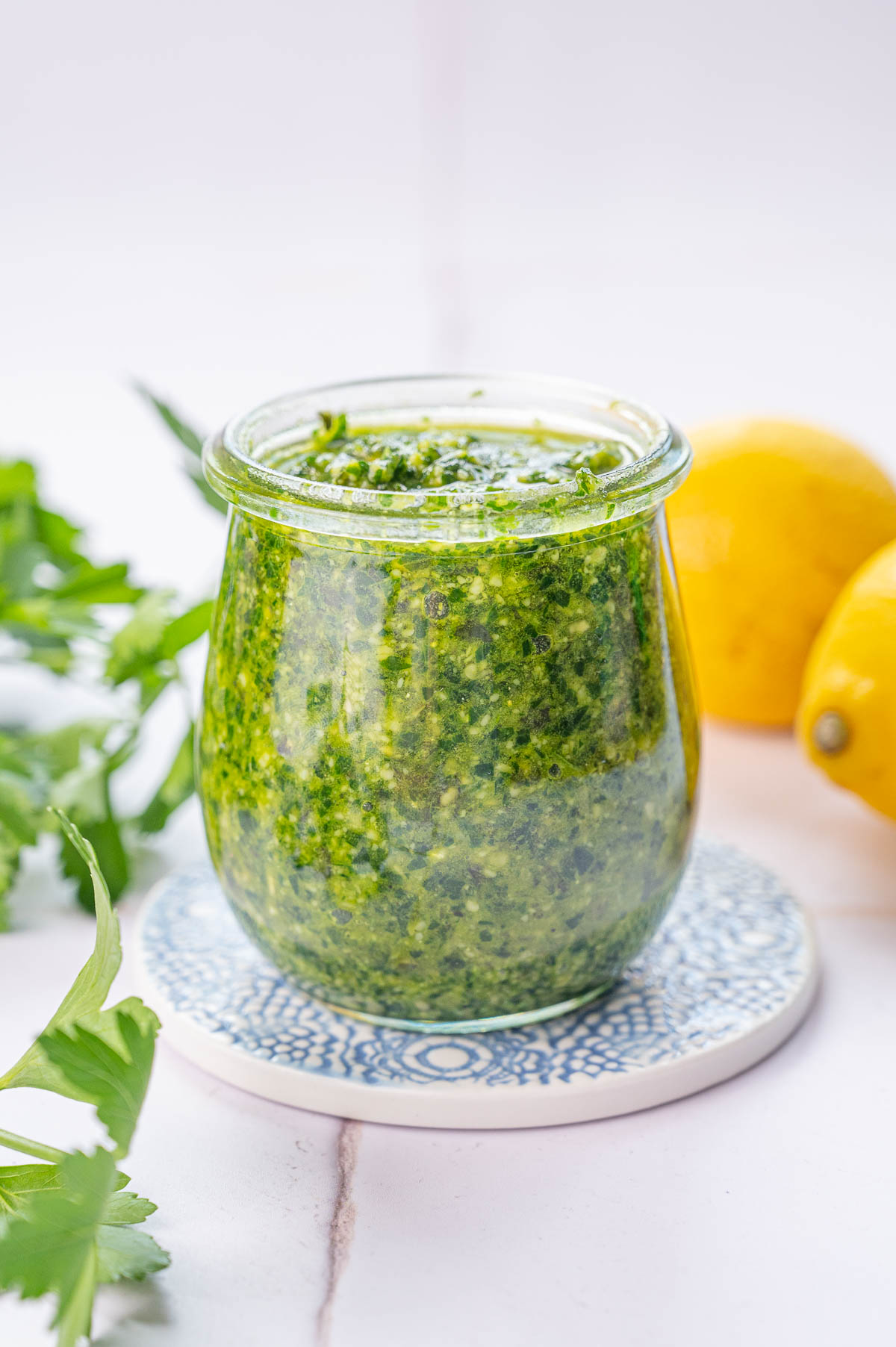
Ingredients
Here’s what you need to make parsley pesto:
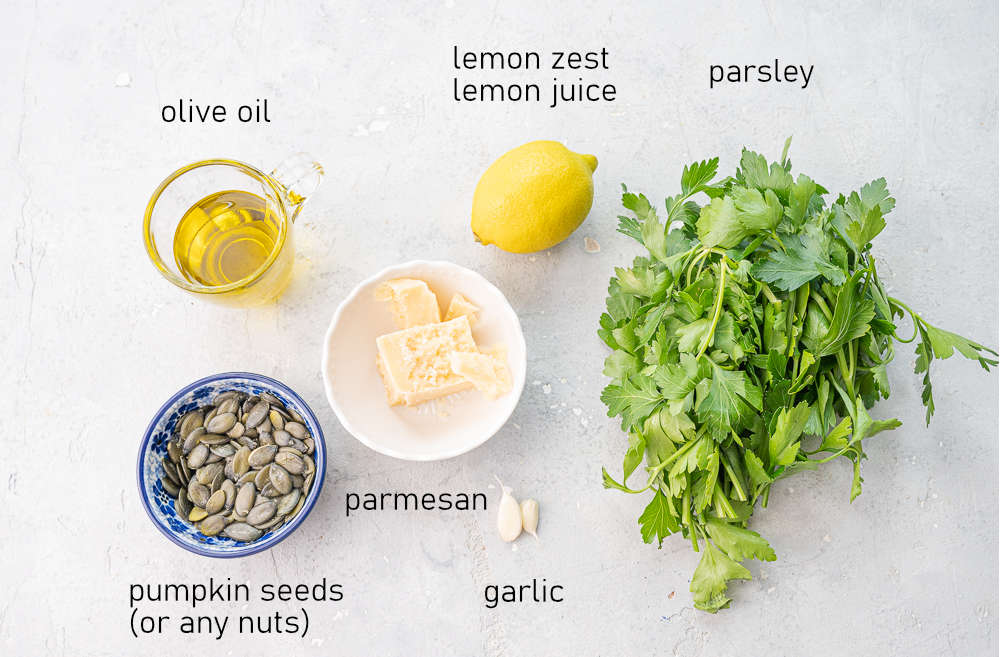
- parsley – use flat-leaf parsley (also known as Italian parsley) for this recipe (curly parsley can also be used but flat-leaf parsley has more flavor), use just leaves – stems have a more bitter flavor and are too tough
- parmesan cheese – use original Italian Parmigiano Reggiano for the best flavor, it’s better to grate it yourself than to use pre-grated cheese
- olive oil
- fresh garlic
- nuts – any nuts will work with this recipe, I used pumpkin seeds but a great option are also almonds, pistachios, walnuts, or pine nuts
- lemon juice and lemon zest – brighten up the sauce, don’t skip them! please use freshly squeezed lemon juice
- you could also add some red pepper flakes to your pesto if you’d like it more spicy
What does parsley pesto taste like?
Parsley is a great substitute for basil in a pesto sauce. Parsley pesto tastes similar to basil pesto but there are some differences.
It’s less fragrant (doesn’t have that perfume-like scent as basil does), it’s more bitter, less sweet, peppery, and have a more vegetable/leafy flavor. Don’t worry though, if served with pasta its flavor is hard to distinguish from the flavor of basil pesto. Parsley pesto is really delicious – it tastes bright, fresh, herby, and slightly garlicky.
Equipment needed
The best appliance for this pesto is a food processor or hand (immersion) blender.
High power full-size stand blender can also be used but it would be better to double the ingredients or it may come out too chunky.
Pesto can also be made using a mortar and pestle although it is a bit of a workout.
How to make parsley pesto step by step
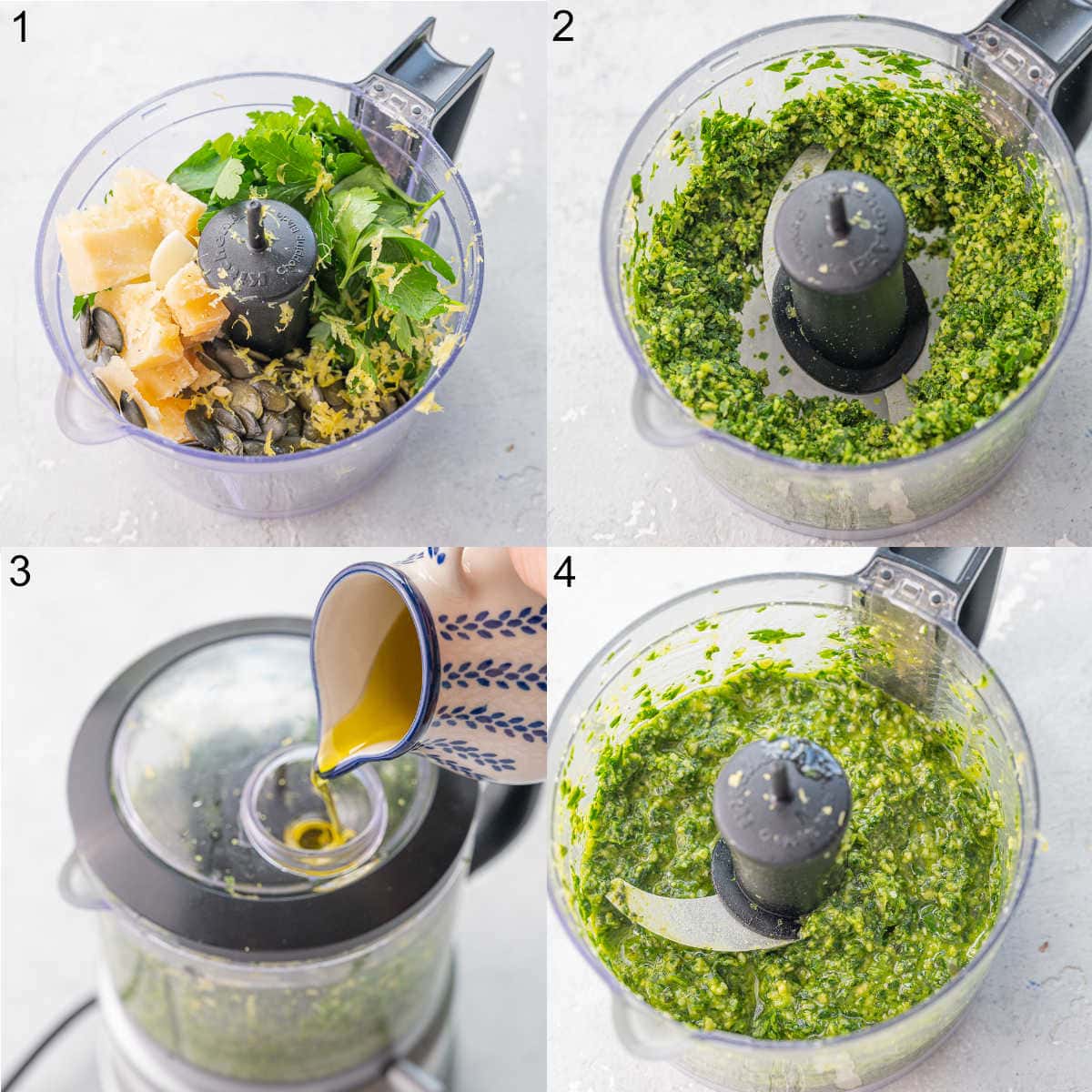
STEP 1: Add all the ingredients for the pesto except the olive oil to a food processor.
STEP 2: Pulse until finely chopped. Scrape down the sides of the bowl as needed.
STEP 3: With the food processor running at low speed, add the olive oil in a slow and steady stream until the oil is incorporated.
STEP 4: Season to taste with salt and pepper. If you’d like your pesto sauce thinner, just add more olive oil. If you prefer it on the thicker side, add less olive oil.
Enjoy!
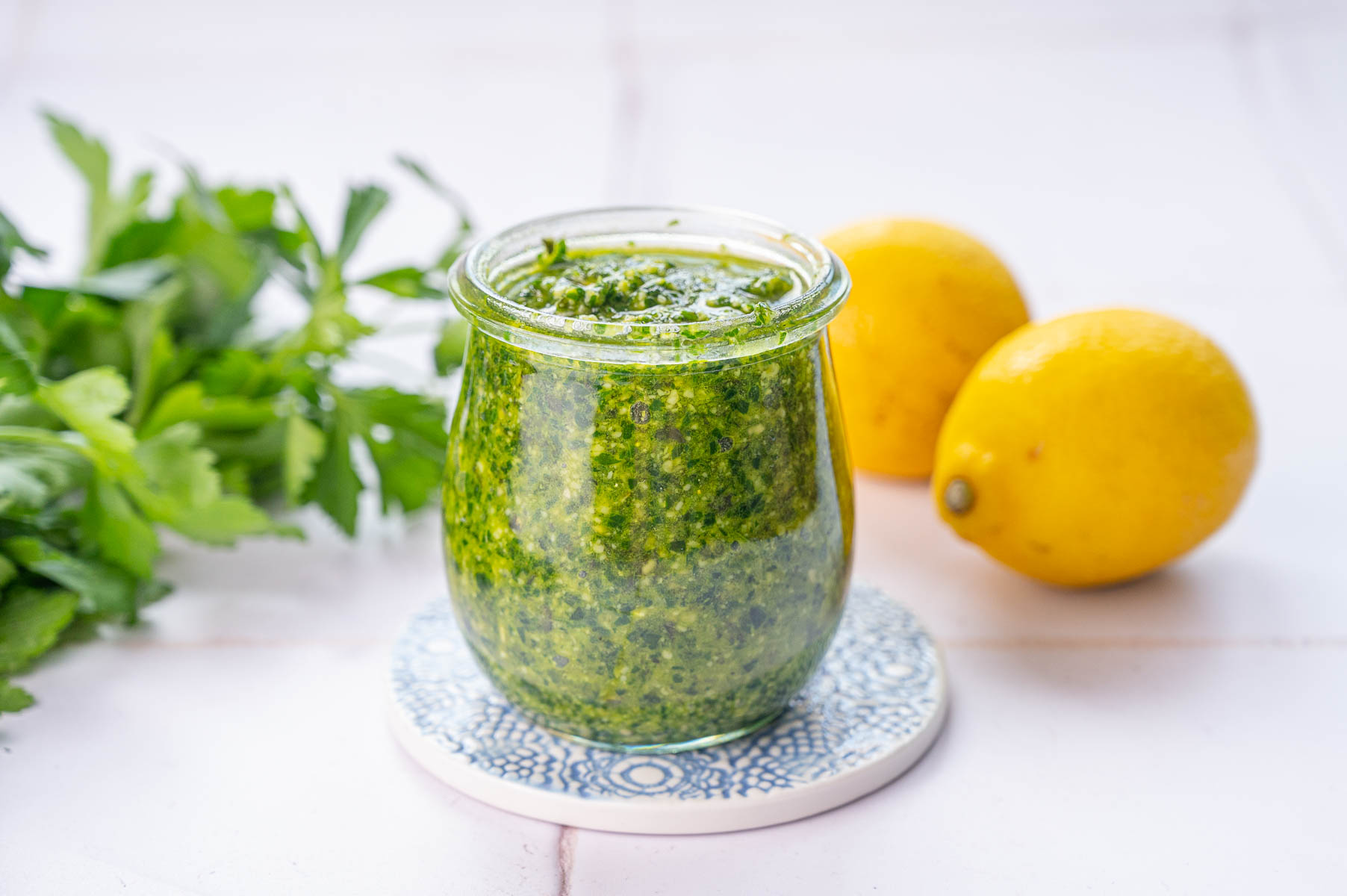
Top tips
- In contrary to basil pesto, which I prefer rather chunky, it’s best to process parsley pesto until almost smooth. Parsley leaves are less delicate than basil leaves and when too coarsely chopped, they can be too noticeable.
- For a more pronounced nutty flavor, you can toast the nuts/seeds first in a dry pan for a minute or so over low heat until lightly browned and fragrant. Transfer them quickly from the pan to the food processor – they can burn quickly.
- Don’t mix the sauce after adding olive oil over high speed or it may turn bitter. You want to pulse it very gently over the lowest speed.
Storage and freezing
Parsley pesto will keep up in the fridge for up to 3 days (stored in a tightly closed container or tightly covered with plastic foil). If you want to keep it longer, pour a small layer of olive oil on top of the pesto. This way you can keep it in the fridge for up to a week.
Pesto freezes very well. Put it in a tightly closed container or plastic bag and freeze for up to 6 months.
Parsley pesto uses
Pesto makes everything taste better! Its uses are countless. Use it as:
- Pasta sauce.
- Salad dressing (thin it out with more olive oil or water).
- Spread on toast, bruschetta, focaccia, sandwich, pizza, flatbread or panini.
- Toss on top of steamed / fresh / roasted veggies.
- As a sauce for a burger.
Recipes:
- Parsley Pesto Pasta
- Pesto Potato Salad
- Shrimp Pesto Pasta
- Pesto Chicken Bake
- Puff Pastry Christmas Tree
- Burrata Pasta
Here you’ll find all my ideas and recipes with pesto.
More delicious pesto recipes
- Sun-Dried Tomato Pesto (Red Pesto)
- Arugula Pistachio Pesto
- Celery Leaf Pesto
- Wild Garlic Pesto (Ramp pesto)
- Classic Basil Pesto (with pine nuts)
- Basil Walnut Pesto
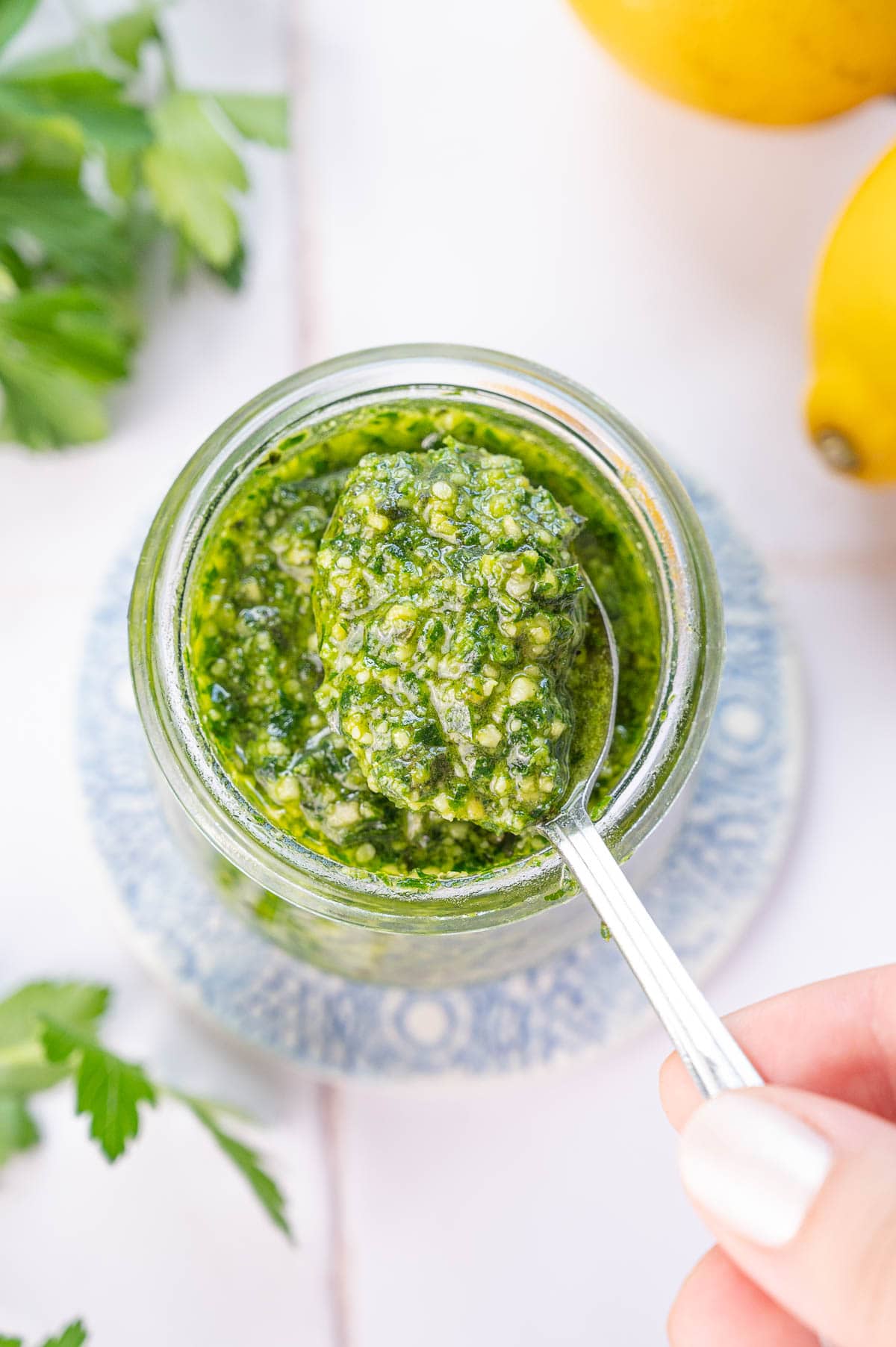
Did you make this recipe? RATE THE RECIPE or tell me in the COMMENTS how you liked it! You can also add a photo of your dish. It would make me very happy and will help other readers. Thank you!!
Parsley Pesto
Ingredients
- 2 lightly packed cups (35g) flat-leaf parsley leaves 2 small bunches
- 1/2 cup grated (45g) parmesan cheese
- 3 tablespoons (25g) pumpkin seeds or pistachios walnuts/almonds/pine nuts are also great
- zest grated of 1 lemon
- 2 teaspoons lemon juice
- 2 cloves garlic
- 1/4 cup + 2 tablespoons olive oil
- salt and pepper to taste
Would you like to save this?
Instructions
- Add all the ingredients for the pesto except the olive oil to a food processor.
- Pulse until finely chopped. Scrape down the sides of the bowl as needed.
- With the food processor running at low speed, add the olive oil in a slow and steady stream until the oil is incorporated.
- Season to taste with salt and pepper. If you’d like your pesto sauce thinner, just add more olive oil. If you prefer it on the thicker side, add less olive oil.
- Enjoy!
Notes
- In contrary to basil pesto, which I prefer rather chunky, it’s best to process parsley pesto until almost smooth. Parsley leaves are less delicate than basil leaves and when too coarsely chopped, they can be too noticeable.
- For a more pronounced nutty flavor, you can toast the nuts/seeds first in a dry pan for a minute or so over low heat until lightly browned and fragrant. Transfer them quickly from the pan to the food processor – they can burn quickly.
- Calories = whole recipe, about 3/4 of a cup. This is only an estimate!



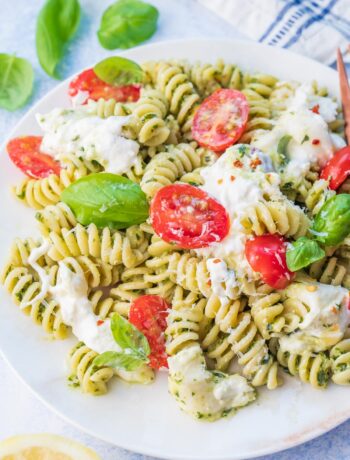


No Comments